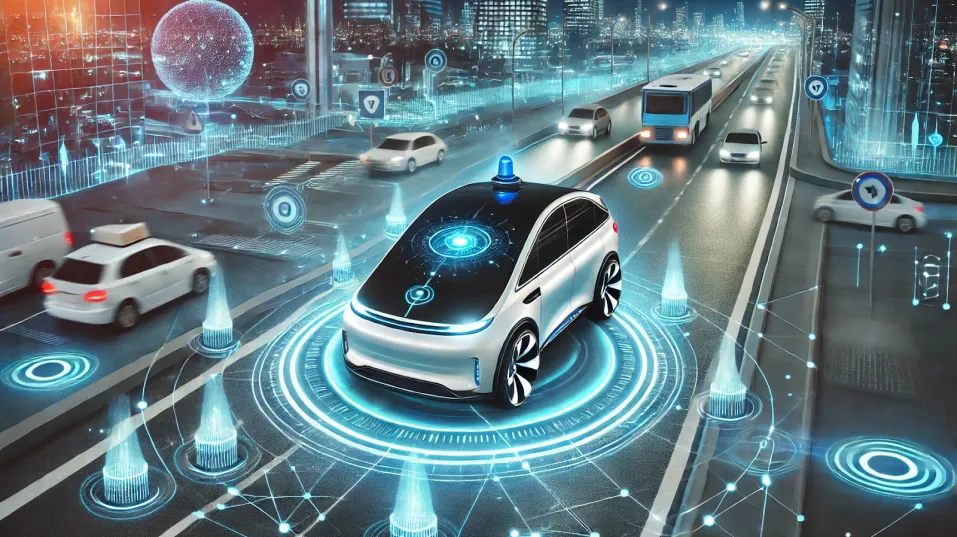Autonomous Vehicles: The Future of Self-Driving Cars

Autonomous vehicles, also known as self-driving cars, are transforming the way we travel in the future. These cars provide better safety, higher efficiency, & more convenience for people. Although this technology is still in development, it is improving rapidly, and we can already see more advanced features of self-driving cars on the roads today.
Technologies like artificial intelligence (AI), machine learning, & smart sensors help autonomous vehicles like cars drive safely. These technologies allow vehicles like self-driving cars to make the right decisions even in difficult situations. As these technologies improve, self-driving cars will change the way we travel. They will also help to make cities better, reduce traffic problems, & make life more comfortable.
The Rapid Growth and Adoption of Autonomous Vehicles
In recent years, the growth of autonomous vehicles (AVs) & self-driving vehicle technology has seen important progress. These vehicles are supported by technologies like:-
- Machine Learning
- Smart sensors
- Advanced Driver Assistance Systems (ADAS)
- Artificial Intelligence (AI)
The progress in autonomous car technology is mainly driven by rapid advancements in technology. There is also a growing demand for smarter and safer mobility solutions.
Experts believe that the future of self-driving vehicle technology is very promising, and within the next 20 years. These vehicles are expected to become a regular part of our everyday lives. The global market for autonomous car technology is also predicted to grow at a fast pace.
Early examples like driverless public transportation & last-mile delivery services clearly show how self-driving vehicle technology can improve the safety and efficiency of transportation.
With continuous improvements in machine learning, smart sensors, and Advanced Driver Assistance Systems (ADAS), artificial intelligence (AI) in autonomous cars, along with the introduction of new government policies to support this technology, autonomous vehicles are set to play a key role in the future of how people & goods will move from place to place.
Understanding the Potential of Autonomous Vehicle Technology
Autonomous vehicles (AVs) hold the potential to transform transportation by offering safer roads, cleaner urban environments, and increased accessibility.
Safety Improvements:
- AVs could reduce traffic deaths by up to 36,000 annually, as human error is responsible for 94% of crashes.
Environmental Benefits:
- AV adoption could cut greenhouse gas emissions by 20% and optimize fuel use, reducing energy consumption by up to 90%.
Addressing Congestion and Accessibility:
- AVs could reduce urban congestion by 40% and provide greater mobility for the elderly and disabled, improving inclusivity.
The global push for self-driving tech is advancing with ML, sensor technologies, and AI in autonomous cars are pushing industry leaders to bring autonomous cars into everyday life.
How does an Autonomous Vehicle Work?
An autonomous vehicle combines sensors like cameras, Lidar, and radar with AI algorithms to interpret surroundings and make driving decisions. These systems control steering, acceleration, and braking, enabling safe and efficient navigation in real-time.
Key Features of Autonomous Vehicles
Advanced features in self-driving or autonomous cars ensure safe and efficient operation:
Advanced Driver-Assistance Systems : ADAS features like cruise control, automatic braking, and lane-keeping enhance safety and convenience.
- Real-Time Data Processing: Constant info processing for quick decisions.
- Vehicle-to-Everything Communication: Communicates with other cars, lights, pedestrians.
- Redundancy Systems: Equipped with safety systems in case of failure.
- Energy-Efficient Driving Modes: Modes to save fuel or battery.
The 6 Levels of Autonomous Vehicle
Here are the 6 Levels of Autonomous Vehicle to help us understand how technology in self-driving cars is classified, starting from basic driver assistance to fully driverless cars
- Level 0: No automation; the driver handles all tasks.
- Level 1: Basic driver help, like cruise control or lane-keeping.
- Level 2: The vehicle can steer and accelerate, but the driver must always supervise.
- Level 3: Conditional automation, where the car handles most tasks but may need human intervention in complex situations.
- Level 4: High automation. Can drive on its own in most cases, but only in certain areas.
- Level 5: Full automation. No human help needed, works anywhere.
What Are the Challenges with Autonomous Vehicles?
While there are plenty of benefits, here are a few reasons why autonomous vehicles have not become mainstream:
- Technical Issues: The LiDAR and AI in autonomous cars are sophisticated; however, adverse weather like heavy rain or snow affects the operations.
- Legal and Regulatory Issues: Laws in each country vary. A plethora of regulations does not contribute to much momentum.
- Ethical Issues: There are concerns regarding how the autonomous vehicles should respond to complex situations such as unavoidable accidents.
- High Costs: Developing this advanced technology requires significant investments, which often leads to higher prices for buyers.
- Public Credibility: For adoption, self driving cars must give confidence to consumers for safety and reliability.
Why Autonomous Vehicles Matter?
Autonomous vehicle technology has the potential to transform transportation by improving road safety, reducing traffic congestion, and enhancing accessibility for all. By leveraging advanced technologies, they aim to minimize human error, optimize fuel efficiency, and support sustainable mobility solutions. Their impact extends beyond convenience, shaping smarter cities and redefining the future of transportation systems.
The impact of autonomous vehicles on redefining the future of transportation cannot be overstated.
- Safer Roads: Fewer human errors mean fewer accidents. Save lives and reduce injuries.
- Smarter Cities: Improved traffic flow. Less congestion. Faster commutes. Better city planning.
- Eco-Friendly: Efficient driving lowers emissions. Good for the planet.
- More Mobility: Helps those who can't drive. Improves daily life.
The Benefits of Autonomous Vehicles
The adoption of autonomous driverless vehicles will bring transformative benefits beyond mere convenience. Here's a closer look at how these vehicles could reshape society:
1.Improved Road Safety
Human mistake is one of the leading causes of car accidents, responsible for almost 90% cases worldwide. Self-driving cars avoid risks that occur with distracted, drowsy, or impaired driving, making roads safer.
2. Reduced Traffic Congestion
Autonomous vehicles (AVs) leverage communication with each other and city infrastructure to streamline traffic movement. This technology enhances traffic efficiency, reduces delays, and alleviates congestion in busy urban areas.
3. Increased Accessibility
For the elderly, specially abled, or individuals without driving licences, this autonomous driving technology is a newfound independence and mobility.
4. Environmental Sustainability
How do AVs help with environmental sustainability?
- Fuel Efficiency: AVs route and drive better, use less fuel and emissions.
- Electric Integration: Many AVs are electric, no tailpipe emissions and less fossil fuels.
- Reduced Congestion: AVs reduce traffic, less emissions and better air quality.
- Shared Mobility: AVs promote car sharing, fewer vehicles on the road and less environmental impact.
- Less Noise Pollution: Electric AVs are quieter, less noisy in urban areas. AVs can reduce the carbon footprint of transportation and a cleaner more efficient future.
5. Productivity and Convenience
This can be consumed by commuters as time to work, relax, or even doze off; the wastage of time is now transformed into useful time.
Summarizing: Autonomous Driving – Steps to the Self-Driving Car
Autonomous vehicles are not just a future dream; they are becoming a reality. These self-driving cars promise safer roads, less traffic, and more comfort for people in the years to come. Although there are some challenges, the benefits of autonomous vehicles clearly show their importance in shaping the future of transportation. As technology improves and more autonomous driving features are introduced, the way we travel will continue to change for the better.
Today’s autonomous car technology uses artificial intelligence (AI), smart sensors, and advanced systems to make cars safer and more helpful for people. These steps explain how autonomous driving features are improving over time.
- Driver Assistance
At this first stage, the driver controls the car fully. Simple tools like cruise control and lane-keeping assist help, but the human stays responsible. - Partial Automation
The car can handle both steering and speed in some situations, but the driver must stay alert and ready to take control. This is where self-driving car technology starts becoming more visible. - Conditional Automation
In specific conditions, such as slow traffic or highways, the car can manage driving on its own. However, the driver must be prepared to take over. This shows the growing power of autonomous vehicle technology. - High Automation
The car can drive itself in certain locations, like cities or highways, without human help. This is a major step towards the autonomous vehicles' future and the future of autonomous driving. - Full Automation
In the final stage, the car can drive anywhere in any condition without a driver. This is the dream of self-driving cars, where people won’t need to touch the steering wheel at all.
Suzuki R&D India’s Role in Transforming AV Transportation
Suzuki R&D India is driving innovation in autonomous vehicle (AV) technology, focusing on AI-powered decision-making, advanced sensors, and smart connectivity through 5G. Future trends include integrating AVs with electric powertrains, addressing regulatory challenges, and reshaping transportation with shared mobility models. These advancements position SRDI as a key player in building safer, smarter, and more sustainable transportation systems.
